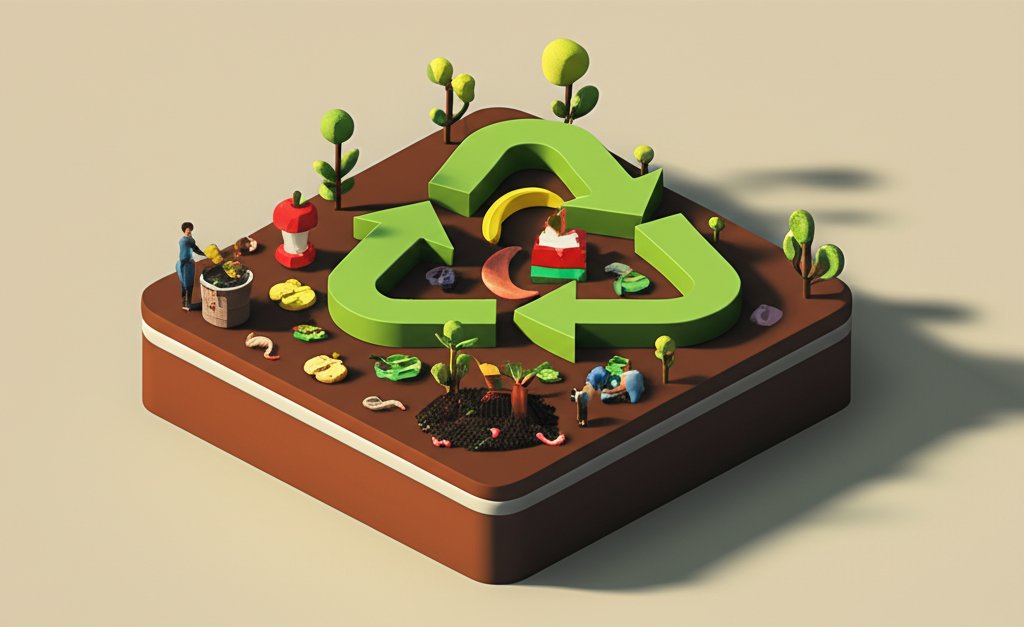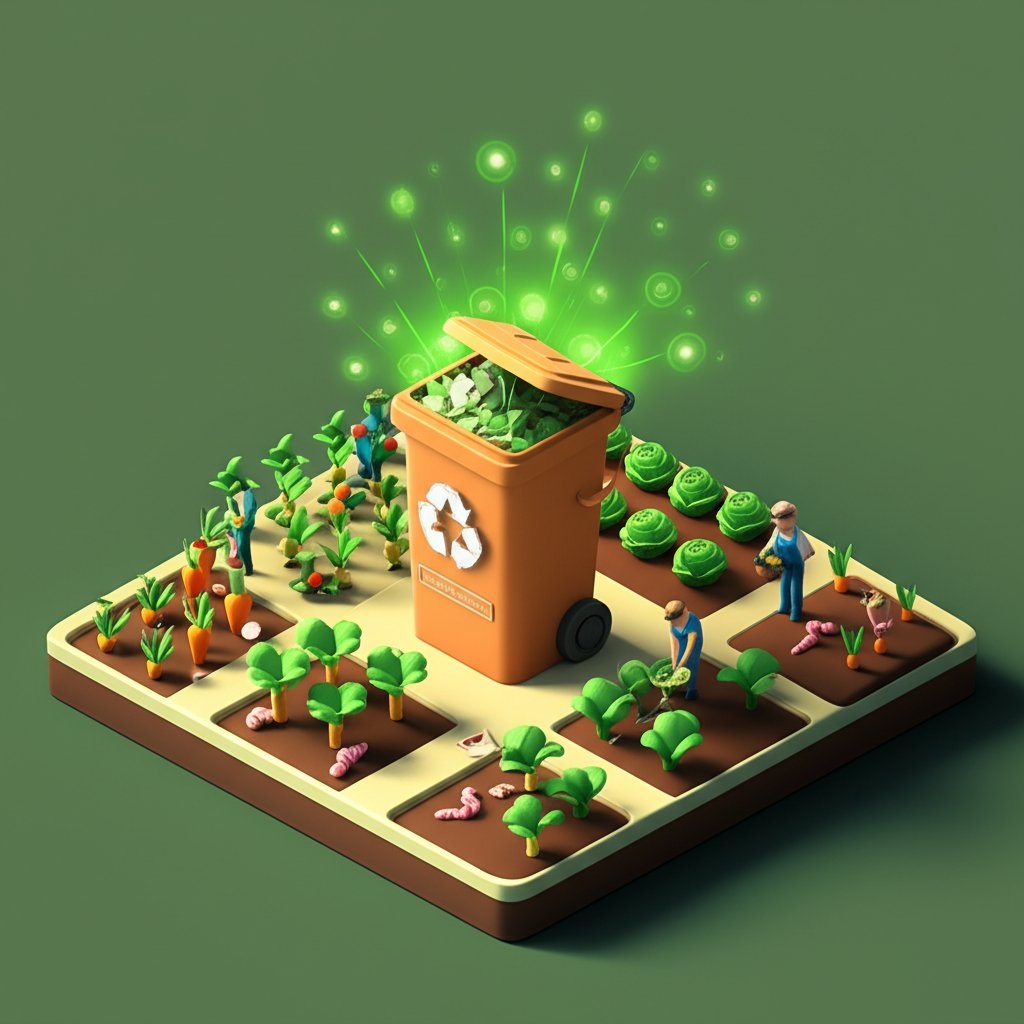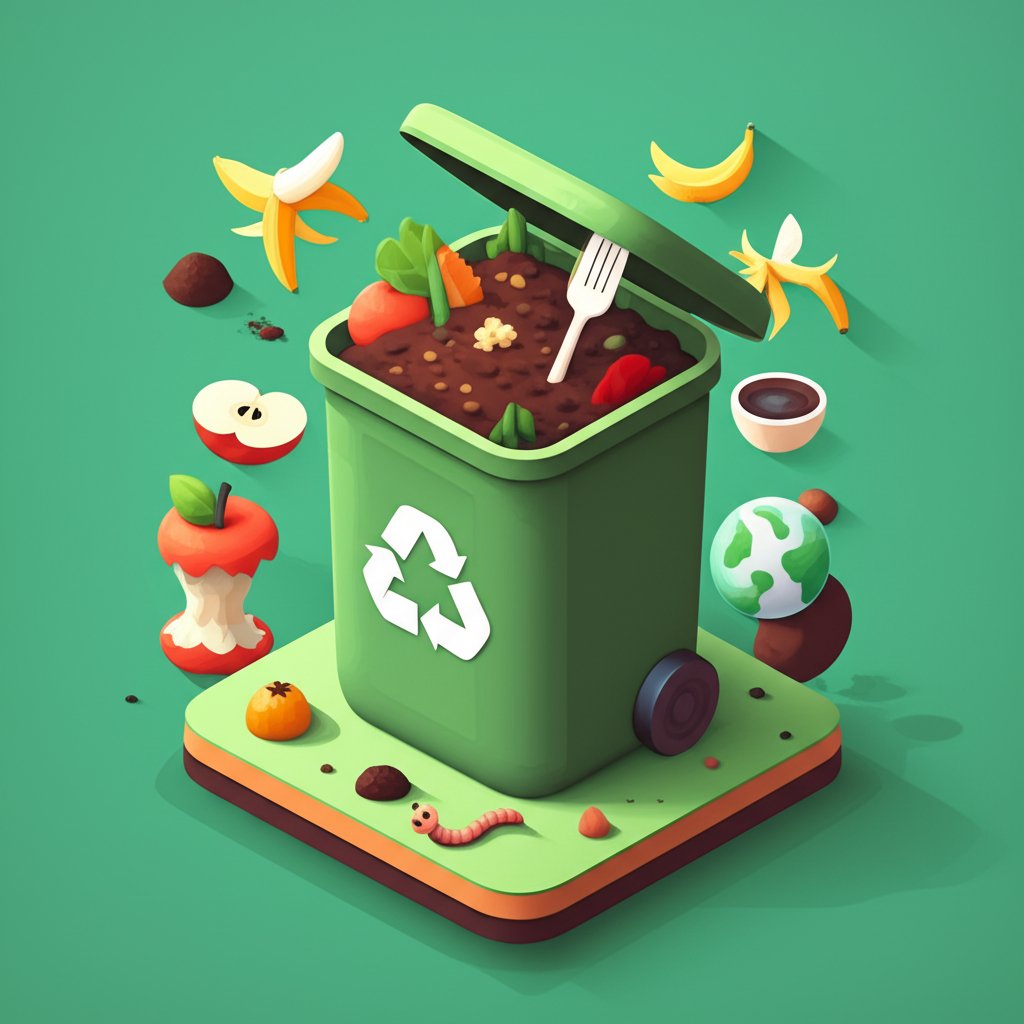Are you ready to turn your kitchen waste into a valuable resource for your garden and contribute to a more sustainable future? Composting is a natural process that transforms organic matter, like food scraps and yard waste, into a nutrient-rich soil amendment. This “black gold,” as some call it, can revitalize your garden, reduce your carbon footprint, and save you money on fertilizers. This comprehensive guide delves into the fascinating world of composting food facts, offering everything you need to know to become a composting pro. We’ll explore the science behind composting, the different methods available, what you can and can’t compost, and how to troubleshoot common composting problems. Get ready to unlock the secrets of sustainable living and transform your waste into wonder!
The Science of Composting: A Microbial Ecosystem
Composting isn’t just about piling up food scraps and waiting; it’s a carefully orchestrated dance between microorganisms, air, water, and organic matter. Understanding the science behind it can drastically improve your composting success.
The Role of Microorganisms
Bacteria, fungi, and actinomycetes are the key players in the composting process. These microscopic organisms break down the organic material, releasing nutrients that plants can use. Bacteria are the workhorses of the process, especially in the initial, hotter phases. Fungi are essential for breaking down tougher materials like lignin and cellulose. Actinomycetes give compost that earthy smell and help break down complex organic compounds.
The Carbon-to-Nitrogen Ratio
The carbon-to-nitrogen (C:N) ratio is a crucial factor in composting. Microorganisms need both carbon and nitrogen to thrive. Carbon provides energy, while nitrogen is essential for building proteins. The ideal C:N ratio for composting is around 25:1 to 30:1. Too much carbon slows down decomposition, while too much nitrogen can lead to unpleasant odors. Achieving the right balance is vital for a healthy compost pile.
Aerobic vs. Anaerobic Decomposition
Composting primarily relies on aerobic decomposition, meaning it requires oxygen. Aerobic microorganisms break down organic matter more efficiently and produce fewer odors. Anaerobic decomposition, which occurs in the absence of oxygen, is much slower and produces foul-smelling gases like methane and hydrogen sulfide. Regularly turning your compost pile ensures adequate aeration and prevents anaerobic conditions.
Temperature and the Composting Process
The temperature of your compost pile is a good indicator of its activity. As microorganisms break down organic matter, they generate heat. A well-managed compost pile can reach temperatures of 130-160°F (54-71°C), which is hot enough to kill weed seeds and harmful pathogens. This is often referred to as the “thermophilic” stage. As decomposition slows down, the temperature will gradually decrease. The compost timeline master details each of these stages.
Choosing the Right Composting Method for You
There are several composting methods to choose from, each with its own advantages and disadvantages. The best method for you will depend on your space, time, and resources.
Backyard Composting: Piles, Bins, and Tumblers
Backyard composting is the most common method for home gardeners. It involves creating a compost pile or using a composting bin. Piles are the simplest option, but they can be less efficient and more prone to pests. Bins provide better insulation and containment. Compost tumblers are rotating containers that make turning the compost easier and faster.
Vermicomposting: Composting with Worms
Vermicomposting uses worms, typically red wigglers (Eisenia fetida), to break down food scraps. Worms consume the organic matter and excrete nutrient-rich castings, which are an excellent soil amendment. Vermicomposting is ideal for smaller spaces and can be done indoors.
Bokashi Composting: Fermenting Food Waste
Bokashi composting is an anaerobic fermentation process that uses inoculated bran to pickle food waste. The fermented material is then buried in the soil, where it decomposes quickly. Bokashi composting can handle a wider range of food waste than traditional composting, including meat and dairy.
Sheet Composting: Building Soil Directly in the Garden
Sheet composting, also known as lasagna gardening, involves layering organic materials directly on the garden bed. This method builds soil gradually over time and is a great way to improve soil structure and fertility.
Community Composting: Sharing the Benefits
If you don’t have space for composting at home, consider joining a community composting program. These programs collect food scraps from residents and businesses and compost them on a larger scale. Unlock composting power, and then share those benefits with your community.
What to Compost: A Comprehensive Guide
Knowing what to compost is essential for successful composting. While many organic materials are suitable for composting, some should be avoided.
The “Greens”: Nitrogen-Rich Materials
“Greens” are nitrogen-rich materials that provide the fuel for microbial activity. Common greens include:
- Fruit and vegetable scraps
- Coffee grounds and tea bags
- Grass clippings
- Fresh manure
- Green leaves
The “Browns”: Carbon-Rich Materials
“Browns” are carbon-rich materials that provide bulk and aeration to the compost pile. Common browns include:
- Dry leaves
- Shredded paper and cardboard
- Straw
- Wood chips
- Sawdust
Items to Avoid Composting
Certain items should be avoided due to the potential for attracting pests, creating odors, or introducing harmful pathogens. These include:
- Meat and dairy products
- Oily foods
- Diseased plants
- Pet waste
- Chemically treated wood
Composting Food Scraps: Specific Considerations
Different types of food scraps require different considerations. For example, citrus peels can be composted, but they should be used in moderation as they can lower the pH of the compost pile. Onions and garlic can also be composted, but they may deter worms in vermicomposting systems. Understanding these nuances can help you optimize your composting process.
Maintaining Your Compost Pile: The Key to Success
Maintaining your compost pile is crucial for ensuring efficient decomposition and preventing problems like odors and pests.
Turning and Aerating the Compost
Turning the compost pile regularly is essential for providing oxygen to the microorganisms. Turning also helps to distribute moisture and mix the materials. How often you need to turn the compost depends on the method and the conditions. Generally, turning the pile every week or two is sufficient.
Moisture Management: Keeping the Compost Damp
Moisture is another critical factor in composting. The compost pile should be damp, like a wrung-out sponge. Too much moisture can lead to anaerobic conditions, while too little moisture can slow down decomposition. Water the compost pile as needed to maintain the proper moisture level.
Balancing the Carbon-to-Nitrogen Ratio
Maintaining the proper C:N ratio is essential for efficient composting. If the compost pile is decomposing too slowly, add more greens. If it’s producing unpleasant odors, add more browns. Experiment with different ratios to find what works best for you.
Monitoring Temperature and Adjusting Accordingly
Monitoring the temperature of your compost pile can provide valuable insights into its activity. Use a compost thermometer to check the temperature regularly. If the temperature is too low, add more greens and ensure adequate moisture. If the temperature is too high, turn the pile more frequently to provide aeration.
Troubleshooting Common Composting Problems
Even with the best intentions, composting can sometimes present challenges. Here are some common problems and how to solve them.
Unpleasant Odors: Identifying and Eliminating the Source
Unpleasant odors are a common sign of anaerobic conditions. To eliminate odors, turn the compost pile more frequently to provide aeration. Add more browns to balance the C:N ratio. Avoid composting meat, dairy, and oily foods, as these can contribute to odors.
Slow Decomposition: Speeding Up the Process
Slow decomposition can be frustrating. To speed up the process, ensure that the compost pile is properly aerated and moistened. Add more greens to increase the nitrogen content. Chop up larger materials into smaller pieces to increase the surface area for microbial activity. Master fast composting, by employing techniques to manage these factors.
Pest Problems: Preventing and Controlling Infestations
Pests can be attracted to compost piles, especially if they contain meat, dairy, or oily foods. To prevent pest problems, avoid composting these items. Cover the compost pile with a layer of browns to deter animals. Use a composting bin with a lid to contain the materials.
Weed Seeds and Pathogens: Achieving Thermophilic Temperatures
High temperatures during the thermophilic stage of composting can kill weed seeds and harmful pathogens. To ensure that the compost pile reaches these temperatures, maintain a proper C:N ratio, moisture level, and aeration. Turn the compost pile regularly to distribute the heat evenly.
The Benefits of Using Compost: From Garden to Globe

Using compost offers a multitude of benefits, both for your garden and for the environment.
Improving Soil Health and Fertility
Compost is a natural soil amendment that improves soil structure, water retention, and fertility. It adds organic matter to the soil, which helps to loosen compacted soils and improve drainage. Compost also provides essential nutrients for plant growth, reducing the need for chemical fertilizers.
Reducing the Need for Chemical Fertilizers
Chemical fertilizers can harm the environment by polluting waterways and disrupting soil ecosystems. Compost provides a natural source of nutrients, decreasing reliance on synthetic fertilizers. This not only benefits the environment but also saves you money.
Conserving Water: Improving Water Retention
Compost improves the water-holding capacity of the soil, reducing the need for frequent watering. This is especially important in dry climates or during periods of drought. By using compost, you can conserve water and save money on your water bill.
Reducing Landfill Waste and Greenhouse Gas Emissions
Composting diverts food scraps and yard waste from landfills, reducing waste volume and methane emissions. Methane is a potent greenhouse gas that contributes to climate change. By composting, you can reduce your carbon footprint and help to mitigate climate change. This is unlocking composting’s power!
Composting for Kids: Instilling Sustainable Habits Early

Teaching children about composting is a great way to instill sustainable habits early on.
Engaging Children in the Composting Process
Make composting fun for kids by involving them in the process. Let them help gather food scraps and yard waste. Explain the science behind composting in a simple and engaging way. Let them help turn the compost pile and monitor the temperature.
Fun Activities and Educational Games
Create fun activities and educational games to teach children about composting. Have them sort different types of waste into compostable and non-compostable categories. Play a game where they identify the different microorganisms involved in composting.
The Importance of Sustainability: A Lesson for Life
Teaching children about composting is more than just teaching them about gardening; it’s teaching them about sustainability and the importance of protecting the environment. By composting, children can learn about waste reduction, resource conservation, and the interconnectedness of ecosystems. Turn this into a learning process by composting for kids.
Fun Facts About Compost: Surprising and Interesting Tidbits
Composting is a fascinating process with many surprising and interesting facts.
The History of Composting: Ancient Practices
Composting has been practiced for thousands of years. Ancient civilizations, such as the Romans and Egyptians, used compost to improve soil fertility and crop yields.
Composting Around the World: Different Techniques
Composting techniques vary around the world, depending on the climate, resources, and cultural practices. For example, in some parts of Asia, bokashi composting is a common method.
Composting Records: The Biggest Compost Pile
The world’s largest compost pile is said to be located in Denmark and measures over 100 acres in size. It is used to compost organic waste from the city of Copenhagen. It’s just one of the mind blowing fun facts about composting!
The Future of Composting: Innovations and Advancements
Composting technology is constantly evolving. New innovations, such as automated composting systems and bioaugmentation techniques, are making composting more efficient and accessible.
Compost Around the Home
From reducing waste to creating a healthier, more thriving garden, adding compost to your waste stream provides many benefits. Also, composting may be older than you think – how old is compost exactly?
Composting food waste is a simple yet impactful way to create a more sustainable future. By understanding the science, methods, benefits, and best practices, you can transform your kitchen scraps into a valuable resource for your garden and the environment. Start composting today and experience the rewards of a greener lifestyle!
Frequently Asked Questions (FAQ)
Q: What is the ideal carbon-to-nitrogen ratio for composting?
A: The ideal C:N ratio is around 25:1 to 30:1.
Q: How often should I turn my compost pile?
A: Generally, turning the pile every week or two is sufficient.
Q: What are some common signs of anaerobic conditions in a compost pile?
A: Unpleasant odors and slow decomposition are common signs of anaerobic conditions.
Q: Can I compost meat and dairy products?
A: It is generally not recommended to compost meat and dairy products, as they can attract pests and create odors.
Q: How long does it take to make compost?
A: Composting time varies depending on the method and the conditions. It can take several months to a year for the compost to be ready.










